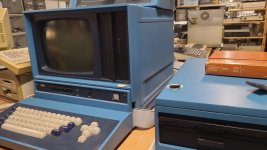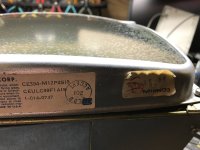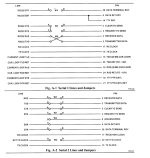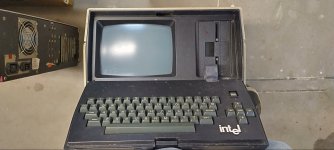Upcoming Events:
| VCF West | Aug 01 - 02 2025, | CHM, Mountain View, CA |
| VCF Midwest | Sep 13 - 14 2025, | Schaumburg, IL |
| VCF Montreal | Jan 24 - 25, 2026, | RMC Saint Jean, Montreal, Canada |
| VCF SoCal | Feb 14 - 15, 2026, | Hotel Fera, Orange CA |
| VCF Southwest | May 29 - 31, 2026, | Westin Dallas Fort Worth Airport |
| VCF Southeast | June, 2026 | Atlanta, GA |
-
Please review our updated Terms and Rules here
You are using an out of date browser. It may not display this or other websites correctly.
You should upgrade or use an alternative browser.
You should upgrade or use an alternative browser.
Mystery Machine
- Thread starter DougM
- Start date
Adriaan
Experienced Member
Hi All,
I'm new to this forum, and stumbled upon this while looking for:

This is the system I'm currently working on.
I'm a volonteer with the Studie Verzameling Universiteit Twente (Study Collection University of Twente, Netherlands)
As a system it's working, we can load a program (Isis II) to it, but the keyboard has flaws: some keys aren't doing what they suppose to do.
Especially the : is out (like some other keys) while the 4 key gives a number of (random) characters.
I was measuring with my ohm-meter and that didn't made any sense, my logic analyser said most keys are doing what they suppose to do, but some arent, while using the ohm-meter they all looked the same to me.
It took some time for me to realise that the keyboard keys are no ordinary on/off type of switches, instead they are HALL-SWITCHES!
So now my queste is to find a place where to find and buy a handfull of these hall-keyboard switches.
I'm new to this forum, and stumbled upon this while looking for:

This is the system I'm currently working on.
I'm a volonteer with the Studie Verzameling Universiteit Twente (Study Collection University of Twente, Netherlands)
As a system it's working, we can load a program (Isis II) to it, but the keyboard has flaws: some keys aren't doing what they suppose to do.
Especially the : is out (like some other keys) while the 4 key gives a number of (random) characters.
I was measuring with my ohm-meter and that didn't made any sense, my logic analyser said most keys are doing what they suppose to do, but some arent, while using the ohm-meter they all looked the same to me.
It took some time for me to realise that the keyboard keys are no ordinary on/off type of switches, instead they are HALL-SWITCHES!
So now my queste is to find a place where to find and buy a handfull of these hall-keyboard switches.
pbirkel@gmail.com
Veteran Member
https://groups.google.com/g/intel-devsys includes many owners of that MDS system. I suggest making an inquiry there.Hi All,
I'm new to this forum, and stumbled upon this while looking for:
Regarding failed Intel MDS keyboard hall-effect switches, there’s a solution demonstrated in this video:
If many of the hall-effect sensors have failed, it may be most efficient to replace all of the keyswitches.
On reading MDS disks - this is an outline of a large topic.
As previously noted, a repository is hosted by Mark Ogden. The disks are recorded in two formats: as an ImageDisk (Dave Dunfield’s DOS software) IMD file, and as a collection of the files extracted from the image.
It’s recommended to check whether the Intel disks you have are already documented. The identifier of each disk is Intel’s ‘Order Code’. The first part of this is a sequence number, ending with a ‘-‘ (dash). In the late 1970s, these carried a prefix of ‘95’ to indicate single density (Frequency Modulation encoding) or ‘97’ to indicate double-density (M2FM encoding). The second part is a revision code which may be ‘A’, ‘B’, etc or ‘001’, 002’. In time, the Order Codes changed to a sequence starting ‘10xxx …’.
While FM encoding is handled by some floppy controller ICs, none of them were designed to work with M2FM encoding. That’s why flux imaging tools are required for Intel's double-density (M2FM) MDS disks. (Note: Intel’s later systems, including iPDS-100 and System 310, 320, etc. used 5¼ inch floppy media with MFM encoding which can be read and written via standard floppy controller ICs).
Assuming you have some Intel-provided disks (not in the repository) and some ‘user data’ disks, here are a few hints about preserving the data.
1. Check the media by inspecting the condition of the oxide surface. Given reasonable storage, Intel’s own media have survived well. Others not so. If the oxide is dirty or soft, you can read the data, but preparation is vital: wash, dry, bake, apply cyclomethicone, insert in a clean sleeve – finally read a few tracks at a time, cleaning the drive head (with IPA) whenever oxide starts to be deposited.
2. If using a Greaseweazle (GW), save the data in ‘raw’ format. This produces a file for every track and, as default, reads each track multiple times. Find the command line in the GW source files. Eventually, save the 77 tracks in a zip file.
3. Find the tools ‘flux2imd’ and ‘unidsk’ at ogdenpm on github.
4. Flux2imd interprets the flux transitions and produces an ImageDisk image file.
5. Unidsk parses the IMD file and outputs the contained files into a directory named to match the Intel Order Number – or whatever filename was used for the collection of the files from the 77 tracks.
For Greaseweazle in the above, you may be able to substitute applesauce, fluxengine or earlier ‘flux’ handling devices – the field (which changes as software is released) is constantly ‘in flux’.
If you have only single-density disks, you could attach an 8 inch drive to a DOS system and use ImageDisk as the software tool.
As noted by others, intel-devsys includes numerous discussions. These include information about Intel’s manuals for hardware and software.
If many of the hall-effect sensors have failed, it may be most efficient to replace all of the keyswitches.
On reading MDS disks - this is an outline of a large topic.
As previously noted, a repository is hosted by Mark Ogden. The disks are recorded in two formats: as an ImageDisk (Dave Dunfield’s DOS software) IMD file, and as a collection of the files extracted from the image.
It’s recommended to check whether the Intel disks you have are already documented. The identifier of each disk is Intel’s ‘Order Code’. The first part of this is a sequence number, ending with a ‘-‘ (dash). In the late 1970s, these carried a prefix of ‘95’ to indicate single density (Frequency Modulation encoding) or ‘97’ to indicate double-density (M2FM encoding). The second part is a revision code which may be ‘A’, ‘B’, etc or ‘001’, 002’. In time, the Order Codes changed to a sequence starting ‘10xxx …’.
While FM encoding is handled by some floppy controller ICs, none of them were designed to work with M2FM encoding. That’s why flux imaging tools are required for Intel's double-density (M2FM) MDS disks. (Note: Intel’s later systems, including iPDS-100 and System 310, 320, etc. used 5¼ inch floppy media with MFM encoding which can be read and written via standard floppy controller ICs).
Assuming you have some Intel-provided disks (not in the repository) and some ‘user data’ disks, here are a few hints about preserving the data.
1. Check the media by inspecting the condition of the oxide surface. Given reasonable storage, Intel’s own media have survived well. Others not so. If the oxide is dirty or soft, you can read the data, but preparation is vital: wash, dry, bake, apply cyclomethicone, insert in a clean sleeve – finally read a few tracks at a time, cleaning the drive head (with IPA) whenever oxide starts to be deposited.
2. If using a Greaseweazle (GW), save the data in ‘raw’ format. This produces a file for every track and, as default, reads each track multiple times. Find the command line in the GW source files. Eventually, save the 77 tracks in a zip file.
3. Find the tools ‘flux2imd’ and ‘unidsk’ at ogdenpm on github.
4. Flux2imd interprets the flux transitions and produces an ImageDisk image file.
5. Unidsk parses the IMD file and outputs the contained files into a directory named to match the Intel Order Number – or whatever filename was used for the collection of the files from the 77 tracks.
For Greaseweazle in the above, you may be able to substitute applesauce, fluxengine or earlier ‘flux’ handling devices – the field (which changes as software is released) is constantly ‘in flux’.
If you have only single-density disks, you could attach an 8 inch drive to a DOS system and use ImageDisk as the software tool.
As noted by others, intel-devsys includes numerous discussions. These include information about Intel’s manuals for hardware and software.
Adriaan
Experienced Member
Update on my previous post:
I stumbled upon a Facebook thread of the Homecomputermuseum.nl regarding the MDS225 they had donated, but didn’t know what to do with it since it wasn’t a home computer and thus didn’t fit their museum collection.
On reading this I immediately wrote them an email, saying that I know what they could do with it….
So we went to the Home Computer Museum in Helmond, the Netherlands and had a tour and a talk.
The system wasn’t working, mold between the screen and its protective shield and opening the dual 8” drive I noticed corrosion, so all in all in bad condition.
We agreed to take the system with us and hopefully I could at least salvage some Hall switches from the keyboard to put in ours…
So, the first thing I did was connecting the keyboard to our (working) system, to see if and how many key’s where doing wat they should do.
And to my surprise, the keyboard was fully functional (yay!)
Next step is testing the system to see what it can and can’t do.
I stumbled upon a Facebook thread of the Homecomputermuseum.nl regarding the MDS225 they had donated, but didn’t know what to do with it since it wasn’t a home computer and thus didn’t fit their museum collection.
On reading this I immediately wrote them an email, saying that I know what they could do with it….
So we went to the Home Computer Museum in Helmond, the Netherlands and had a tour and a talk.
The system wasn’t working, mold between the screen and its protective shield and opening the dual 8” drive I noticed corrosion, so all in all in bad condition.
We agreed to take the system with us and hopefully I could at least salvage some Hall switches from the keyboard to put in ours…
So, the first thing I did was connecting the keyboard to our (working) system, to see if and how many key’s where doing wat they should do.
And to my surprise, the keyboard was fully functional (yay!)
Next step is testing the system to see what it can and can’t do.
whizzi
Experienced Member
Good to know the system is in good hands nowUpdate on my previous post:
I stumbled upon a Facebook thread of the Homecomputermuseum.nl regarding the MDS225 they had donated, but didn’t know what to do with it since it wasn’t a home computer and thus didn’t fit their museum collection.
On reading this I immediately wrote them an email, saying that I know what they could do with it….
So we went to the Home Computer Museum in Helmond, the Netherlands and had a tour and a talk.
The system wasn’t working, mold between the screen and its protective shield and opening the dual 8” drive I noticed corrosion, so all in all in bad condition.
We agreed to take the system with us and hopefully I could at least salvage some Hall switches from the keyboard to put in ours…
So, the first thing I did was connecting the keyboard to our (working) system, to see if and how many key’s where doing wat they should do.
And to my surprise, the keyboard was fully functional (yay!)
Next step is testing the system to see what it can and can’t do.
Are these those Honeywell SD series switches? I was about to ask if you're going to gut a keyboard I'd be interested in some spares (reason: the DIY solution I have isn't made for pounding on keys https://forum.vcfed.org/index.php?threads/alphatronic-p2-restoration.1244514/#post-1338755) , but it looks like the MDS uses four terminal switches instead of the three terminal ones in the Alphatronic
Attachments
shirsch
Veteran Member
This may be the least of your immediate problems, but it's fixable with a bit of care. I performed cataract surgery on my MDS-230 last fall and it worked out well. Be sure to wear protective gear if you attempt this: safety goggles, heavy sweatshirt and gloves. First problem is getting access to the join between the tube front and shatter shield. It's under the tension band, so first step is to carefully cut it cross-wise with a dremel grinder and peel off the band. There's a thick layer of glue underneath so make sure you stop as soon as your're through the steel. Once the tension is released it should peel off easily. You will now be able to get to the side of the silicone layer and saw off the shatter shield. I used a 0.010 guitar string wrapped around a pair small wood blocks to use as handles. There are a few videos on YouTube that talk about this part of the operation if you want to pursue it..... mold between the screen and its protective shield
Here are some before and after photos.



Adriaan
Experienced Member
Yes, they have the 4 pin switches, that was confusing me in the first place.Are these those Honeywell SD series switches? I was about to ask if you're going to gut a keyboard I'd be interested in some spares (reason: the DIY solution I have isn't made for pounding on keys https://forum.vcfed.org/index.php?threads/alphatronic-p2-restoration.1244514/#post-1338755) , but it looks like the MDS uses four terminal switches instead of the three terminal ones in the Alphatronic
But since the (defective) keyboard is not my personal property but belongs to the study collection of the University, it is not to me to decide what to do with it.
But I will ask about it shortly and get back to you.
Adriaan
Experienced Member
Thank you for your elaborate explanation how to remove the mold from within the screen, but I’m not sure what will happen with the system with this contaminated screen…This may be the least of your immediate problems, but it's fixable with a bit of care. I performed cataract surgery on my MDS-230 last fall and it worked out well. Be sure to wear protective gear if you attempt this: safety goggles, heavy sweatshirt and gloves. First problem is getting access to the join between the tube front and shatter shield. It's under the tension band, so first step is to carefully cut it cross-wise with a dremel grinder and peel off the band. There's a thick layer of glue underneath so make sure you stop as soon as your're through the steel. Once the tension is released it should peel off easily. You will now be able to get to the side of the silicone layer and saw off the shatter shield. I used a 0.010 guitar string wrapped around a pair small wood blocks to use as handles. There are a few videos on YouTube that talk about this part of the operation if you want to pursue it.
Here are some before and after photos.View attachment 1276476View attachment 1276477View attachment 1276478
Adriaan
Experienced Member
Some progress with our system, now I’m able to send data vise versa between the Intel MDS-225 and a Windows XP computer using Kermit.
Which makes me think Serial CH2/TTY is defective because I can’t get this port to work while Serial CH1 does.
Look:
Which makes me think Serial CH2/TTY is defective because I can’t get this port to work while Serial CH1 does.
Look:
No need to ask, the switches I've got are 3 pin so probably incompatible without additional modifications. They're just from the same series it appearsYes, they have the 4 pin switches, that was confusing me in the first place.
But since the (defective) keyboard is not my personal property but belongs to the study collection of the University, it is not to me to decide what to do with it.
But I will ask about it shortly and get back to you.
Adriaan
Experienced Member

Serial 2 proved to be working as well!
I failed to notice that, although the serial section (pins 2 and 3) of the connectors at the outside of the system are named equally, the rxd and txd wires are twisted in the Serial 1 wiring. All it took was a null modem cable to get Kermit working on Serial 2 as well
Oh, btw, the system we have appears to be a MDS-226
appleIImidi
Experienced Member
Dear Adriaan,View attachment 1276566
Serial 2 proved to be working as well!
I failed to notice that, although the serial section (pins 2 and 3) of the connectors at the outside of the system are named equally, the rxd and txd wires are twisted in the Serial 1 wiring. All it took was a null modem cable to get Kermit working on Serial 2 as well
Oh, btw, the system we have appears to be a MDS-226
I do have one of these systems pretty complete with EPROM burner and a 8048 incircuit emulator.
It would be great if you know someone who could make use of the system. I don’t want to just throw it away, I worked with those systems in the early 1980s
Werner
Al Kossow
Documentation Wizard
It would be great if you know someone who could make use of the system. I don’t want to just throw it away
where are you located?
Adriaan
Experienced Member
Hi Werner,
I’m to new on this forum so I can’t PM you…
Maybe we (the Study Collection University Twente) are interested in the 8048 incurcuit emulator, I’m not sure we have one.
Is it ok to ask if there is one with our system already or if we ‘need’ one?
I’m to new on this forum so I can’t PM you…
Maybe we (the Study Collection University Twente) are interested in the 8048 incurcuit emulator, I’m not sure we have one.
Is it ok to ask if there is one with our system already or if we ‘need’ one?
pbirkel@gmail.com
Veteran Member
Intellec MDS. There were several models; here's one:That’s definitely a product from Intel’s iPDS (Intel Processor Development System) or Intellec line, likely based on the Multibus architecture.
Intel MDS-II Model 230 Development System
This Intel Intellec MDS-II (Microcomputer Development System) Model 230 from February 1979 has a 6-slot Multibus card cage in the bottom front of the chassis, a large power supply in the middle, a CRT in the top, and an I/O controller board at the back. There is room for an 8" diskette drive to the

